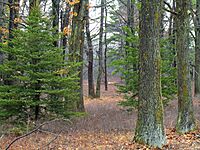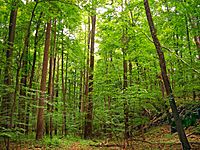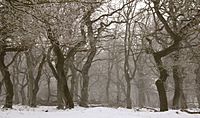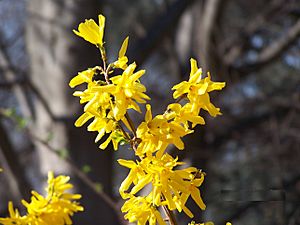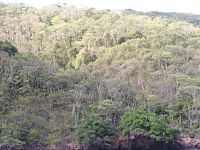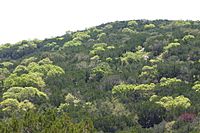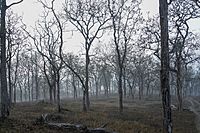Deciduous facts for kids
Have you ever wondered why some trees lose their leaves in the fall? The word deciduous means "falling off at maturity." It describes plants like trees and shrubs that shed their leaves every year. This usually happens in autumn. It can also refer to flowers shedding petals or fruit falling when ripe. The opposite of deciduous is evergreen, which means plants keep their leaves all year.
The term "deciduous" can also describe animal parts. For example, deer have deciduous antlers that fall off. Humans and some other mammals have deciduous teeth, also known as baby teeth, which they lose.
Contents
What Are Deciduous Plants?
In the world of botany (the study of plants) and horticulture (gardening), deciduous plants are those that lose all their leaves for part of the year. This natural process is called abscission.
For plants in temperate or polar climates, leaf loss happens in winter. In warmer places like tropical or dry regions, plants lose their leaves during the dry season. This helps them save water when it's scarce.
The opposite of deciduous plants are evergreen plants. Evergreens shed their leaves slowly over time, so they always look green. Some plants are called semi-deciduous. They lose old leaves as new ones start to grow. Other plants are semi-evergreen. They keep some leaves during winter or dry times before the next growing season.
Many deciduous plants flower when they don't have leaves. This helps them get pollinated better. If a plant is pollinated by wind, the wind can carry pollen more easily without leaves in the way. For plants pollinated by insects, the flowers are easier for insects to see. But this strategy has risks. Flowers can be damaged by frost or by a lack of water in dry seasons.
Why Do Leaves Change Color and Fall?
Leaves start to grow in spring and fall off in autumn. This process is triggered by changes in daylight and air temperatures. Different plant types need different conditions. For example, willows (Salix) grow leaves earlier and lose them later. Trees like ash (Fraxinus) and walnut (Juglans) need warmer temperatures and more daylight to grow leaves. They are also among the first to lose their leaves in the fall.
In very cold places like Alaska, leaves can start changing color as early as August. In most temperate areas, this happens from late September to early November. In warmer, subtropical climates, it might be November or December.
Leaf drop, or abscission, involves complex changes inside the plant. During summer, leaves are dark green because of a pigment called chlorophyll. When autumn arrives, days get shorter and temperatures drop. The chlorophyll in the leaves breaks down. This allows other colors, like yellow, brown, and orange, to show through. These colors come from pigments called carotenoids.
Red and purple colors come from anthocyanin pigments. These are not always in the leaves. They are made in late summer when sugars get trapped in the leaves as they prepare to fall. The brightest autumn colors happen when days are short and nights are cool but not freezing.
Places like New England in the United States and southeastern Canada are famous for their bright autumn colors. This is because they have strong sun during the day and cool nights. Europe often has less vibrant colors due to its humid climate. The Southern United States also has less intense fall colors because it stays warm during autumn. The Western United States has fewer deciduous plants. Most of the Southern Hemisphere has milder winters, so there are not as many deciduous plants. Only places like southern South America and the southern island of New Zealand have distinct fall colors.
The process of leaf drop begins when a special layer forms between the leaf stem (called a petiole) and the main branch. This layer is called the abscission layer. It forms in spring when the leaf is growing. Cells in this layer are sensitive to a plant hormone called auxin. When the leaf produces enough auxin, the cells stay connected. In autumn, or when the plant is stressed, the auxin from the leaf decreases. This causes the cells in the abscission layer to stretch and break apart. This allows the leaf to fall off. The plant also forms a seal at the break point to prevent losing sap.
Some trees, like oaks and beeches, sometimes keep their dead leaves through winter. This is called "marcescence". The leaves only fall off when strong winds blow them away. This happens because the abscission layer doesn't fully develop. You usually see this in young trees.
Before leaves fall, many deciduous plants take back important nutrients like nitrogen and carbon from the leaves. They store these nutrients as proteins in their roots and inner bark. In spring, these stored proteins help the plant grow new leaves or flowers.
Why Are Deciduous Plants Important?
Deciduous plants have both good points and bad points compared to evergreens. One advantage is that they lose their leaves to save water or to survive cold winters. However, they have to use energy to grow new leaves each year. Evergreens don't need to do this.
Evergreens can lose more water in winter. They can also be eaten more by animals, especially when they are small. Deciduous trees are less likely to break from ice storms when they don't have leaves. They also lose less water when liquid water is hard to find in cold winters.
Losing leaves in winter can also reduce damage from insects. It might be easier for the plant to just grow new leaves than to repair old ones. Losing leaves also helps prevent damage to the plant's water-carrying tubes (xylem vessels). This allows deciduous plants to have wider xylem vessels, which means they can take in more water and carbon dioxide during the summer.
Examples of Deciduous Woody Plants
Many different woody plants have developed the deciduous trait. Deciduous trees include maples, many oaks, elms, beeches, aspens, and birches. Some conifers are also deciduous, like larch and Metasequoia. Deciduous shrubs include honeysuckle and viburnum. Most woody vines in temperate areas are also deciduous, such as grapes, poison ivy, Virginia creeper, and wisteria.
This characteristic helps identify plants. For example, in parts of California, you might see deciduous and evergreen oaks growing next to each other. Leaf fall often matches the seasons: winter in cold climates or the dry season in tropical areas. However, tall, tree-like monocotyledonous plants like palms, yuccas, and dracaenas are never deciduous. The hydrangea hirta is a deciduous woody shrub found in Japan.
Deciduous Forests Around the World
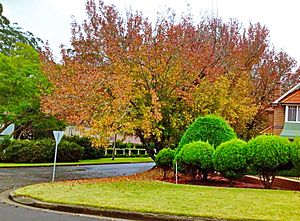
Forests where most trees lose their leaves at the end of the growing season are called deciduous forests. These forests are found all over the world. They have unique ecosystems, with special plants growing beneath the trees and distinct soil types.
There are two main types of deciduous forests:
Temperate deciduous forests are found in North and South America, Asia, Europe, and parts of the Himalayas. They grow in climates where temperatures change a lot with the seasons. Plants grow during warm summers, drop their leaves in autumn, and rest during cold winters. These forests have diverse life forms that are greatly affected by the changing seasons, especially temperature and rainfall.
Tropical and subtropical deciduous forests are different. They lose their leaves not because of temperature changes, but because of seasonal rainfall patterns. During long dry periods, the trees drop their leaves to save water and avoid dying from drought. Leaf drop in these areas doesn't always happen at the same time each year. It can vary by region. Even in a small area, you might see some trees with leaves and some without, depending on how much water is available.
-
Dry-season deciduous tropical forest
-
Mixed tropical and subtropical deciduous forest in spring, Texas, United States
See also
 In Spanish: Caducifolio para niños
In Spanish: Caducifolio para niños


